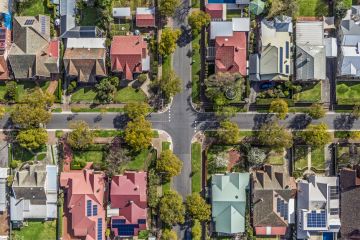Why taxpayers should buy back houses most at risk of natural disaster
Some home owners living in areas at high risk of a natural disaster need to move, and governments need to buy back their homes but the processes for doing so are falling short, new research warns.
A report by the Australian Housing and Urban Research Institute titled Integrating housing policy, settlement planning and disaster management has found that governments need to map land due for retreat and develop a database of land suitable for resettlement.

The issue is becoming more pressing due to climate change, which makes extreme weather events more frequent and means they can have a bigger impact on communities, but this can be a challenging conversation for long-term residents of an area. Some buybacks already in place in Australia have faced community confusion or opposition.
The report, released this week, recommends developing policies for managed retreat and buyback schemes that can be used before and after natural disasters, which should include the community in decision-making.
It highlighted the buybacks offered in the NSW northern rivers after the 2022 Lismore floods, which aimed to provide safer places for people to live but did not have enough community consultation and communication. Concerns were also raised over moving owners from the lowest-value real estate into new homes that were still affordable.
The research drew on interviews with public servants in government and emergency response agencies to find where processes are falling short.
State governments need to plan for buybacks before disasters hit, said lead researcher, RMIT University senior research fellow at the Centre for Urban Research, Dr Annette Kroen.
“At the moment, it’s often an ad hoc response with buyback programs, or thinking about managed retreat. It’s often a reaction to a disaster rather than states having plans for what we want to do when a disaster hits,” she said.
“If we’re prepared ahead of time we can respond a bit easier rather than keeping people waiting.”
In Lismore, she said the buyouts were a long process that had been difficult for some households who did not know if they could move away.

She said disasters become more frequent and impactful due to climate change, which means some long-term locals are unaware of future risks. Instead, they assess risk based on experience.
After a disaster, awareness of risk is high, but it can be politically difficult to talk about relocating communities before a disaster happens, Kroen said.
She called for states to take the lead on making sure different groups have access to the right data to be aware of high-risk areas, then identify land that residents at risk could move to, and prepare a process for a buyback scheme in advance.
She said some new homes might be built in high-risk areas now, which was beyond the scope of the study.
The report follows previous expert calls in this masthead for a managed retreat from residential development on the coastline due to the risk of rising sea levels and coastal erosion.
UTS researcher Simon Bradshaw, who was not involved in the study, agreed governments should support some communities to move to safer locations.
“We do see increasing numbers of households living in harm’s way, exposed to worsening floods or to extreme fire risk,” the research director at Climate-KIC said. “The first priority should be to support households and communities in adapting and building resilience.
“Where that’s not possible … we need to look at ways where people can be supported to move to a safer location and government buybacks are one of the tools that can be used.”

He said more money is spent on cleaning up after disasters than preparing communities, but it was important for communities to have choices and relocation done on their terms.
Without adequate preparation, households which experience a disaster can go through a prolonged period of displacement and uncertainty, he said.
Natural Hazards Research Australia chief executive Andrew Gissing said some communities are already moving to lower-risk areas or being supported to make home modifications and raise their houses.
For example, homes at risk of flooding in western Sydney’s Liverpool, or the Victorian government’s purchases after the Black Saturday bushfires.
But he said it was expensive for governments and relied on communities getting on board.
Some of the home owners in the at-risk pocket of Liverpool had not left at the same time as their neighbours, leaving houses next to vacant blocks and governments still needing to maintain roads and services.
“I would anticipate in the future the demand for those sorts of investments to increase,” he said. “You can’t really expect people to be recovering from large floods back to back.”
We recommend
States
Capital Cities
Capital Cities - Rentals
Popular Areas
Allhomes
More










